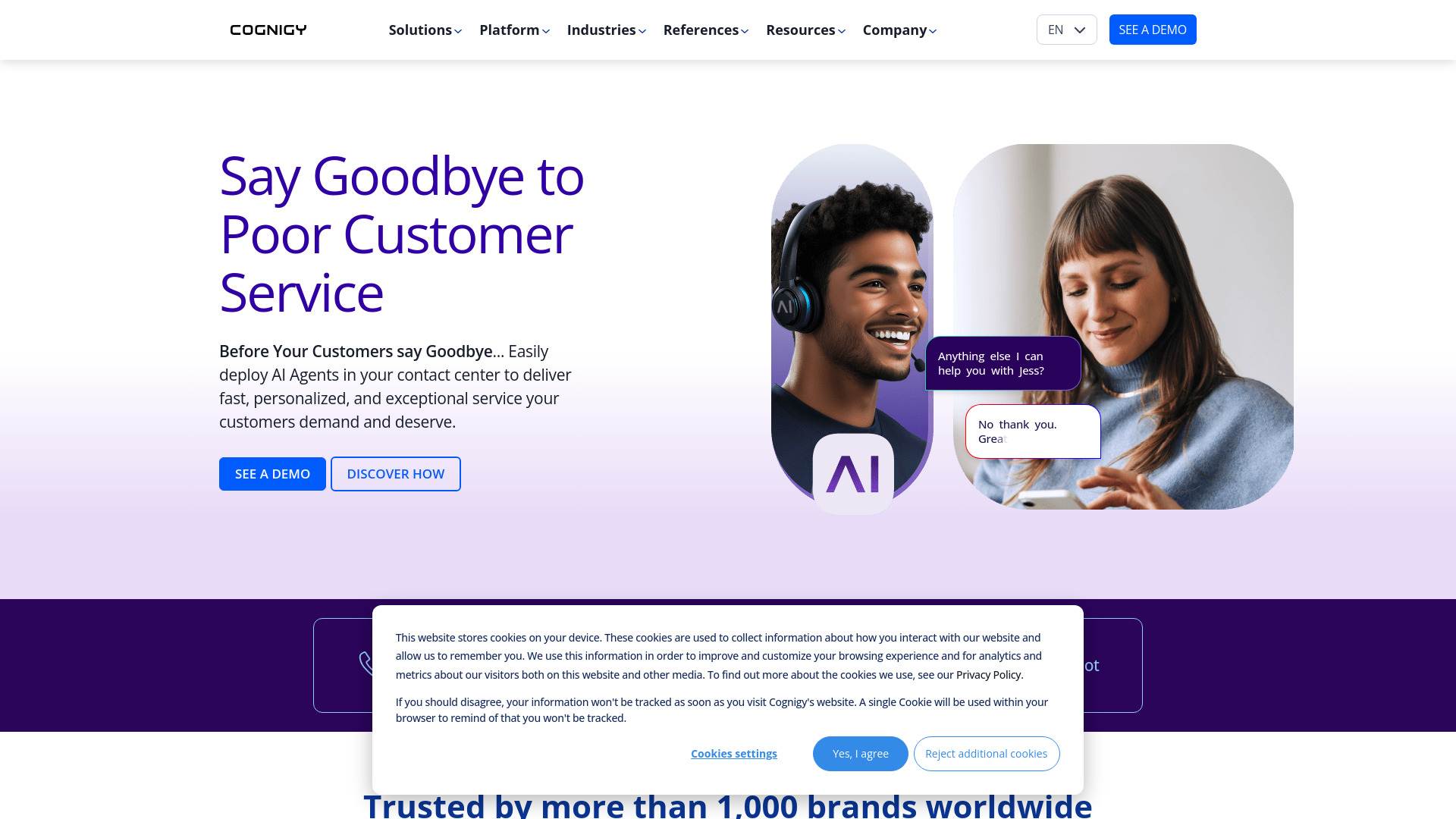- Home
- AI Voice Assistants
- Cognigy

Cognigy
Open Website-
Tool Introduction:Cognigy AI: Generative, agentic CX; deploy AI Agents across channels.
-
Inclusion Date:Nov 01, 2025
-
Social Media & Email:
Tool Information
What is Cognigy AI
Cognigy AI is an enterprise conversational and generative AI platform built for modern customer service. It lets organizations design, deploy, and manage intelligent AI Agents across contact centers to deliver fast, personalized support at scale. Using NLU, Knowledge AI, and Agentic AI, it automates self‑service over voice and chat while augmenting human agents with real‑time guidance. The Cognigy.AI suite adds orchestration, integrations, analytics, and guardrails to create consistent, multimodal experiences and measurable improvements in CX.
Main Features of Cognigy AI
- Omnichannel AI Agents: Build voicebots and chatbots that work across telephony, contact center platforms, and digital channels for seamless customer journeys.
- Generative + Agentic AI: Combine LLM-powered responses with task-oriented agents that can trigger workflows, API calls, and business logic.
- Knowledge AI: Connect FAQs, documents, and knowledge bases to deliver accurate, contextual answers with retrieval and grounding.
- Advanced NLU: Robust intent recognition, entity extraction, and multilingual support for precise understanding across use cases.
- Experience Orchestration: Low-code flow builder to design end-to-end journeys, handoffs, and error handling across channels.
- Agent Augmentation: Real-time agent assist, call summaries, next-best actions, and automated after-call work to boost productivity.
- Multimodal CX: Consistent experiences across voice and text with channel-aware design and reusable components.
- Integrations & Connectors: Plug into CRM, ticketing, CCaaS, RPA, databases, and custom systems via APIs and webhooks.
- Analytics & Monitoring: Track KPIs like containment, AHT, CSAT, and journey-level metrics to optimize outcomes.
- Security & Governance: Enterprise controls for privacy, role-based access, auditing, and response guardrails.
Who Can Use Cognigy AI
Cognigy AI is designed for customer service leaders, contact center operations teams, and CX strategists who want to automate self-service and enhance agent performance. it's also valuable for IT and automation architects integrating AI into CCaaS, CRM, and back-end systems. Typical users include enterprises in banking, insurance, telecom, retail, travel, healthcare, utilities, and e‑commerce seeking scalable, compliant, and reliable AI-driven support.
How to Use Cognigy AI
- Define goals and KPIs such as containment rate, AHT reduction, or CSAT improvement.
- Connect channels by integrating telephony, contact center platforms, and web or messaging endpoints.
- Import or link knowledge sources (FAQs, docs, knowledge bases) for grounded answers.
- Design intents and conversation flows in the low-code builder with guardrails and fallbacks.
- Configure generative and agentic behaviors, including API actions and workflow orchestration.
- Integrate systems like CRM, ticketing, and payment or identity services via connectors and APIs.
- Test with sandbox users, run A/B experiments, and refine prompts, intents, and flows.
- Deploy to production with monitoring, analytics dashboards, and continuous optimization.
- Enable agent assist to provide summaries, recommendations, and automated after-call work.
Cognigy AI Use Cases
Organizations use Cognigy AI to automate contact center interactions and augment agents across industries. Banks and insurers handle card activation, balance inquiries, and claims updates. Telecom providers enable plan changes, outage updates, and billing support. Retailers and e‑commerce brands manage order tracking, returns, and product Q&A. Airlines and travel services process itinerary changes and baggage queries. Healthcare and utilities support appointment scheduling, eligibility checks, payments, and outage reporting. IT service desks use it for password resets and onboarding.
Cognigy AI Pricing
Cognigy AI is typically offered through enterprise, quote-based licensing tailored to channel mix, usage, and integration needs. Organizations can engage the vendor for a demo and a customized plan aligned with their contact center requirements and scale.
Pros and Cons of Cognigy AI
Pros:
- Enterprise-grade omnichannel automation across voice and chat.
- Combines NLU, Knowledge AI, and generative capabilities for accurate, contextual service.
- Low-code orchestration accelerates design and iteration of customer journeys.
- Agent assist features reduce handle time and improve consistency.
- Broad integrations with CRM, CCaaS, and back-end systems.
- Strong analytics and governance for measurable, compliant operations.
Cons:
- Enterprise setup and integrations may require significant implementation effort.
- Learning curve for complex, multi-step flows and orchestration.
- Licensing and usage costs may be high for smaller teams.
- Response quality depends on the freshness and structure of connected knowledge sources.
- Telephony and regulatory requirements can vary by region and vendor stack.
FAQs about Cognigy AI
-
What is Cognigy AI used for?
It powers AI Agents for contact centers, enabling automated self-service and real-time agent assistance across voice and chat.
-
Does Cognigy AI integrate with my existing stack?
Yes. It offers connectors and APIs for CCaaS, CRM, ticketing, and back-end systems to orchestrate tasks and data.
-
Does it support both voice and chat?
Yes. Cognigy AI provides omnichannel support for telephony and digital messaging, enabling consistent experiences.
-
Is coding required to build experiences?
You can design most journeys with a low-code builder, while developers can extend logic with APIs and custom integrations.
-
How does it keep outputs accurate and safe?
Through knowledge grounding, policy guardrails, role-based access, and monitoring to align responses with business rules.
-
Who benefits most from Cognigy AI?
Enterprise contact centers seeking scalable automation, improved CSAT, and agent productivity gains across voice and chat.



